QR Zones of Green Cay Wetlands Boardwalk
Back to Introduction

 Follow this link to see a video presentation of this zone!
Follow this link to see a video presentation of this zone!
As you begin your walk, you first come upon a shallow marsh characterized by a wide diversity of emergent and floating-leaved plant species. In nature, emergent marsh areas represent transitional zones between dry land and water. The diverse combination of emergent marsh plants serve as important habitat for many wetland bird species and increases the amount of nutrients removed from the water. The plants, insects, and fish found in the shallow water of this zone also serve as a key food source for the animals seen here.
Plants: Fireflag, Arrowhead/Duck Potato, Knotted Spikerush, Giant Bulrush, Gulf Coast Spikerush, Bulrush, Pickerelweed, Green Arrow Arum.
Animals: Great Blue Heron, Anhinga, Woodstork, Great Egret, White Ibis, Tree Frogs, Water Snakes.
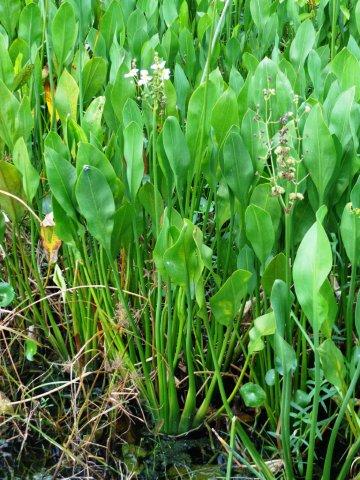
ARROWHEAD - An emersed plant. It's large leaves and conspicuous flowers make it easy to find in the wild. It grows commonly in swamps, ditches, lakes, and stream margins. Arrowhead is also called duck potato because of its potato-like, underground corms that sometimes form. Duck potato has large, firm, lance-shaped leaves, which are typically four inches wide and up to two feet long. Also called Duck Potato.
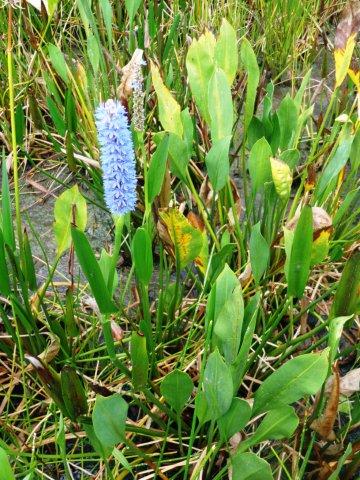
PICKERELWEED - A very common and widely recognized native. It occurs throughout Florida and flowers year-round. Pickerelweed typically grows to about 2 or 3 feet tall. Its leaves are large (up to 5 inches wide) and are usually twice as long. Leaf shapes are variable, but are usually lance-shaped. They may have either a distinctly heart-shaped face or a rounded face. The easiest way to recognize pickerelweed is by its spike of violet-blue flowers. Uncommonly the flowers are white. Many small individual flowers form this flowering spike. The leaf and the flower spike arise from the same stem. Without flowers, pickerelweed can be confused with Sagitarria latifolia, common arrowhead. To distinguish between the two, look at the leaf lobes. Common arrowhead has pointed lobes on its arrow-shaped leaves. Pickerelweed has heart-shaped or rounded lobes on its lance-shaped leaves. Pickerelweed is a common native of Florida. It has a large flowering spike of violet blue or white flowers, heart-shaped leaves with rounded lobes, and its large leaves are about twice as long as they are wide.

GREAT BLUE HERON - A large wading bird and is found throughout most of North America, as far north as Alaska and the southern Canadian provinces. The range extends south through Florida, Mexico and the Caribbean to South America. It is the largest North American heron. It has head-to-tail length 36–54 in, a wingspan of 66–79 in, a height of 45–54 in, and a weight of 4.6–7.9 lb. The primary food for Great Blue Heron is small fish, though it
is also known to opportunistically feed on a wide range of shrimp, crabs, aquatic insects, rodents and other small mammals, amphibians, reptiles, and small birds. Herons locate their food by sight and usually swallow it whole. The Great Blue Heron can adapt to almost any wetland habitat in its range.
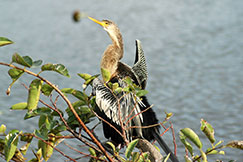
ANHINGA - A water bird of the warmer parts of the Americas. The word anhinga comes from the Brazilian Tupi language and means devil bird or snake bird. The Anhinga often swims with only the neck above water. When swimming in this style the name Snakebird is apparent, since only the colored neck appears above water the bird looks like a snake ready to strike. Unlike ducks, the Anhinga is not able to waterproof its feathers using oil produced by the uropygial gland. Consequently, feathers can become waterlogged, making the bird barely buoyant. However, this allows it to dive easily and search for underwater prey, such as fish and amphibians. It can stay down for significant periods. When necessary, the Anhinga will dry out its wings and feathers by perching for long periods with its wings spread to allow the drying process, as do cormorants. If it attempts to fly while its wings are wet, it has great difficulty getting off the water and takes off by flapping vigorously while "running" on the water.

WOODSTORK - A large American wading bird in the stork family Ciconiidae. It was formerly called the "Wood Ibis", though it is not really an ibis. The Wood Stork is a broad-winged soaring bird that flies with its neck outstretched and legs extended. It forages usually where lowering water levels concentrate fish in open wetlands; it also frequents paddy fields. Walking slowly and steadily in shallow water up to its belly, it seeks prey, which, like that of most of its relatives, consists of fish, frogs and large insects. It catches fish by holding its bill open in the water until a fish is detected.
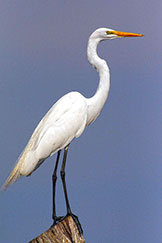
GREAT EGRET - A dazzling sight in many a North American wetland. Slightly smaller and more svelte than a Great Blue Heron, these are still large birds with impressive wingspans. They hunt in classic heron fashion, standing immobile or wading through wetlands to capture fish with a deadly jab of their yellow bill. Great Egrets were hunted nearly to extinction for their plumes in the late nineteenth century, sparking conservation movements and some of the first laws to protect birds. All feathers on Great Egrets are white. Their bills are yellowish-orange, and the legs black. Great Egrets wade in shallow water (both fresh and salt) to hunt fish, frogs, and other small aquatic animals. They typically stand still and watch for unsuspecting prey to pass by. Then, with startling speed, the egrets strike with a jab of their long neck and bill. You’ll find Great Egrets in both freshwater and saltwater habitats. They are colonial nesters, typically placing stick nests high in trees, often on islands that are isolated from mammalian predators such as raccoons.
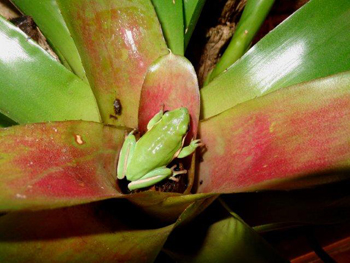
GREEN TREE FROG - Native to Florida and found throughout wet prairies, cypress swamps, hydric hammocks and other areas with floating vegetation or moist conditions. True to its name, the Green Tree Frogs is usually bright green, but its color can vary to yellow, dull green, or slate grey when it is hidden or inactive. A yellow or white stripe may extend farther along the body on one side than on the other, or may be lacking entirely. This relatively small frog ranges from 1 to 2.5 inches in length lives around 2 to 5 years. Because they often appear or are heard during rain storms, folklore and legends regard these frogs to be "weather prophets". They can produce a loud “quank, quank, quank” call that sound much like a cowbell, leading to such nicknames as cowbell frog or bell frog. Their diet consists of beetles, crickets, caterpillars, beetle larvae, stinkbugs, other small invertebrates.
Green Cay Nature Center and Wetlands is owned and operated by the
Palm Beach County Parks and Recreation Department and the
Water Utilities Department.